horn TOYOTA GR YARIS 2021 Owners Manual
[x] Cancel search | Manufacturer: TOYOTA, Model Year: 2021, Model line: GR YARIS, Model: TOYOTA GR YARIS 2021Pages: 458, PDF Size: 105.69 MB
Page 122 of 458
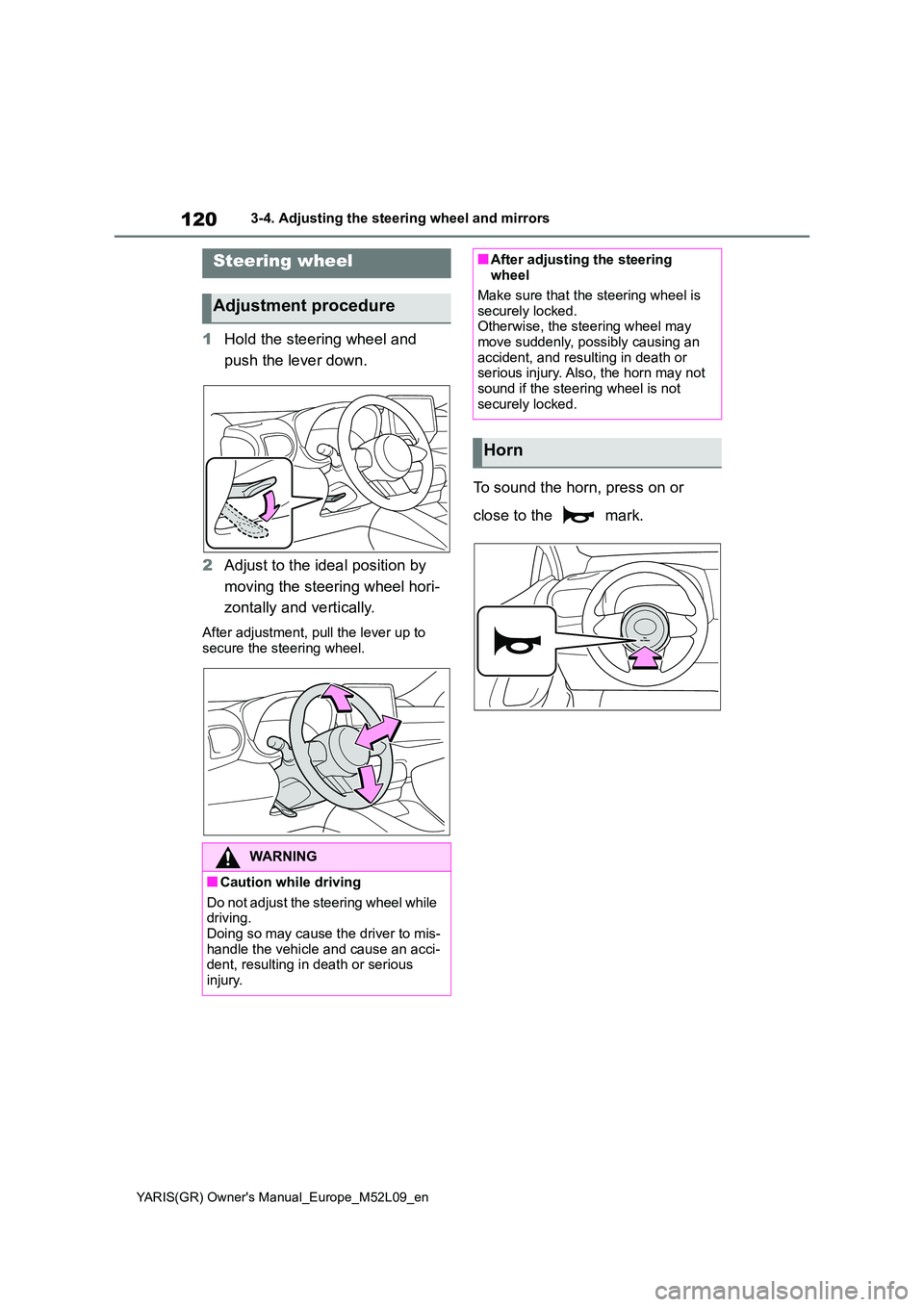
120
YARIS(GR) Owner's Manual_Europe_M52L09_en
3-4. Adjusting the steering wheel and mirrors
3-4.Adjusting the steering whe el an d mirrors
1Hold the steering wheel and
push the lever down.
2 Adjust to the ideal position by
moving the steering wheel hori-
zontally and vertically.
After adjustment, pull the lever up to
secure the steering wheel.
To sound the horn, press on or
close to the mark.
Steering wheel
Adjustment procedure
WARNING
■Caution while driving
Do not adjust the steering wheel while driving.Doing so may cause the driver to mis-
handle the vehicle and cause an acci- dent, resulting in death or serious injury.
■After adjusting the steering wheel
Make sure that the steering wheel is
securely locked. Otherwise, the steering wheel may move suddenly, possibly causing an
accident, and resulting in death or serious injury. Also, the horn may not sound if the steering wheel is not
securely locked.
Horn
Page 211 of 458
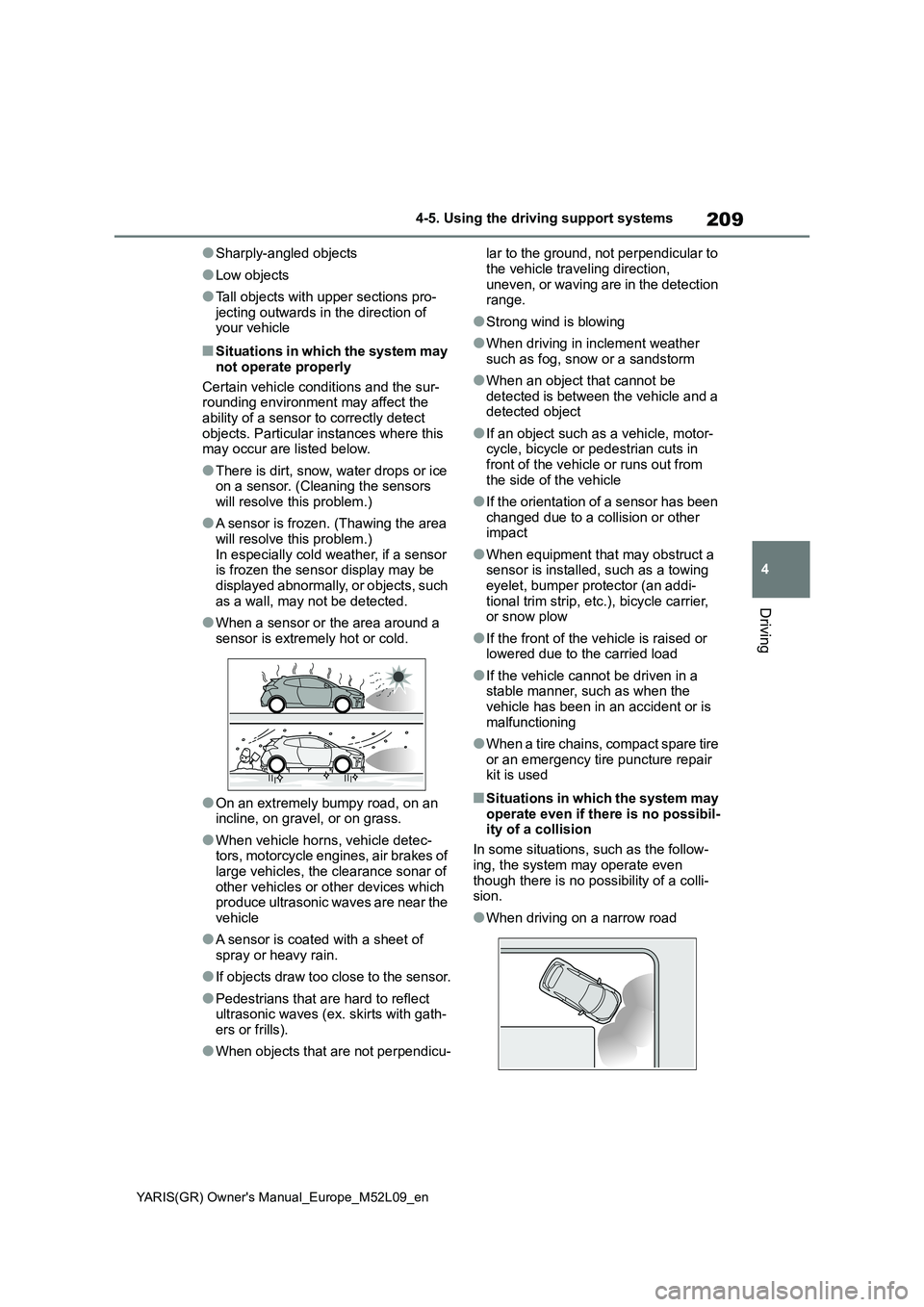
209
4
YARIS(GR) Owner's Manual_Europe_M52L09_en
4-5. Using the driving support systems
Driving
●Sharply-angled objects
●Low objects
●Tall objects with upper sections pro-
jecting outwards in the direction of
your vehicle
■Situations in which the system may
not operate properly
Certain vehicle conditions and the sur-
rounding environment may affect the
ability of a sensor to correctly detect
objects. Particular instances where this
may occur are listed below.
●There is dirt, snow, water drops or ice
on a sensor. (Cleaning the sensors
will resolve this problem.)
●A sensor is frozen. (Thawing the area
will resolve this problem.)
In especially cold weather, if a sensor
is frozen the sensor display may be
displayed abnormally, or objects, such
as a wall, may not be detected.
●When a sensor or the area around a
sensor is extremely hot or cold.
●On an extremely bumpy road, on an
incline, on gravel, or on grass.
●When vehicle horns, vehicle detec-
tors, motorcycle engines, air brakes of
large vehicles, the clearance sonar of
other vehicles or other devices which
produce ultrasonic waves are near the
vehicle
●A sensor is coated with a sheet of
spray or heavy rain.
●If objects draw too close to the sensor.
●Pedestrians that are hard to reflect
ultrasonic waves (ex. skirts with gath-
ers or frills).
●When objects that are not perpendicu-lar to the ground, not perpendicular to
the vehicle traveling direction,
uneven, or waving are in the detection
range.
●Strong wind is blowing
●When driving in inclement weather
such as fog, snow or a sandstorm
●When an object that cannot be
detected is between the vehicle and a
detected object
●If an object such as a vehicle, motor-
cycle, bicycle or pedestrian cuts in
front of the vehicle or runs out from
the side of the vehicle
●If the orientation of a sensor has been
changed due to a collision or other
impact
●When equipment that may obstruct a
sensor is installed, such as a towing
eyelet, bumper protector (an addi-
tional trim strip, etc.), bicycle carrier,
or snow plow
●If the front of the vehicle is raised or
lowered due to the carried load
●If the vehicle cannot be driven in a
stable manner, such as when the
vehicle has been in an accident or is
malfunctioning
●When a tire chains, compact spare tire
or an emergency tire puncture repair
kit is used
■Situations in which the system may
operate even if there is no possibil-
ity of a collision
In some situations, such as the follow-
ing, the system may operate even
though there is no possibility of a colli-
sion.
●When driving on a narrow road
Page 212 of 458
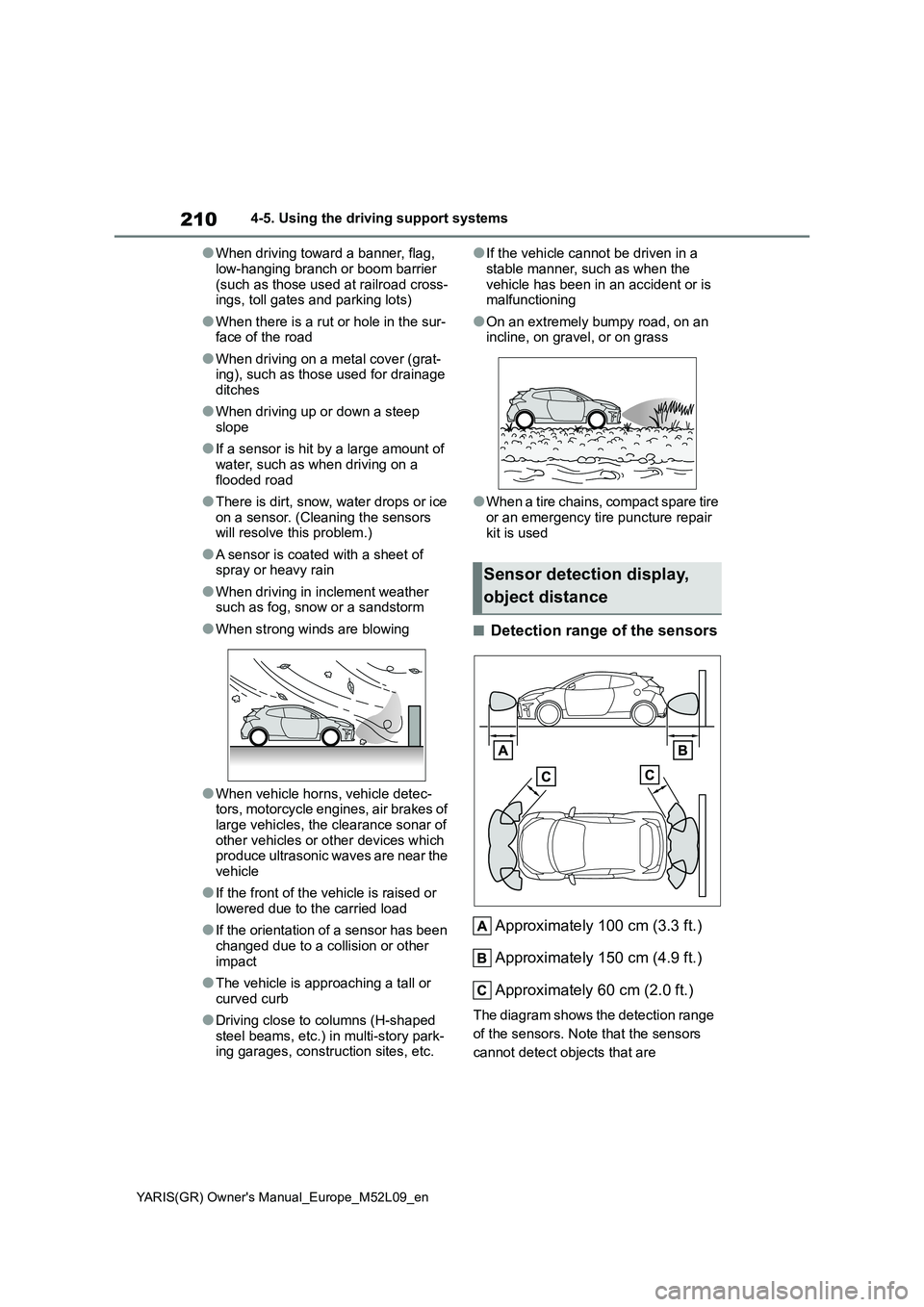
210
YARIS(GR) Owner's Manual_Europe_M52L09_en
4-5. Using the driving support systems
●When driving toward a banner, flag,
low-hanging branch or boom barrier (such as those used at railroad cross-ings, toll gates and parking lots)
●When there is a rut or hole in the sur-face of the road
●When driving on a metal cover (grat-ing), such as those used for drainage
ditches
●When driving up or down a steep
slope
●If a sensor is hit by a large amount of
water, such as when driving on a flooded road
●There is dirt, snow, water drops or ice on a sensor. (Cleaning the sensors will resolve this problem.)
●A sensor is coated with a sheet of spray or heavy rain
●When driving in inclement weather such as fog, snow or a sandstorm
●When strong winds are blowing
●When vehicle horns, vehicle detec-tors, motorcycle engines, air brakes of large vehicles, the clearance sonar of
other vehicles or other devices which produce ultrasonic waves are near the vehicle
●If the front of the vehicle is raised or lowered due to the carried load
●If the orientation of a sensor has been changed due to a collision or other
impact
●The vehicle is approaching a tall or
curved curb
●Driving close to columns (H-shaped
steel beams, etc.) in multi-story park- ing garages, construction sites, etc.
●If the vehicle cannot be driven in a
stable manner, such as when the vehicle has been in an accident or is malfunctioning
●On an extremely bumpy road, on an incline, on gravel, or on grass
●When a tire chains, compact spare tire or an emergency tire puncture repair
kit is used
■Detection range of the sensors
Approximately 100 cm (3.3 ft.)
Approximately 150 cm (4.9 ft.)
Approximately 60 cm (2.0 ft.)
The diagram shows the detection range
of the sensors. Note that the sensors
cannot detect objects that are
Sensor detection display,
object distance
Page 339 of 458
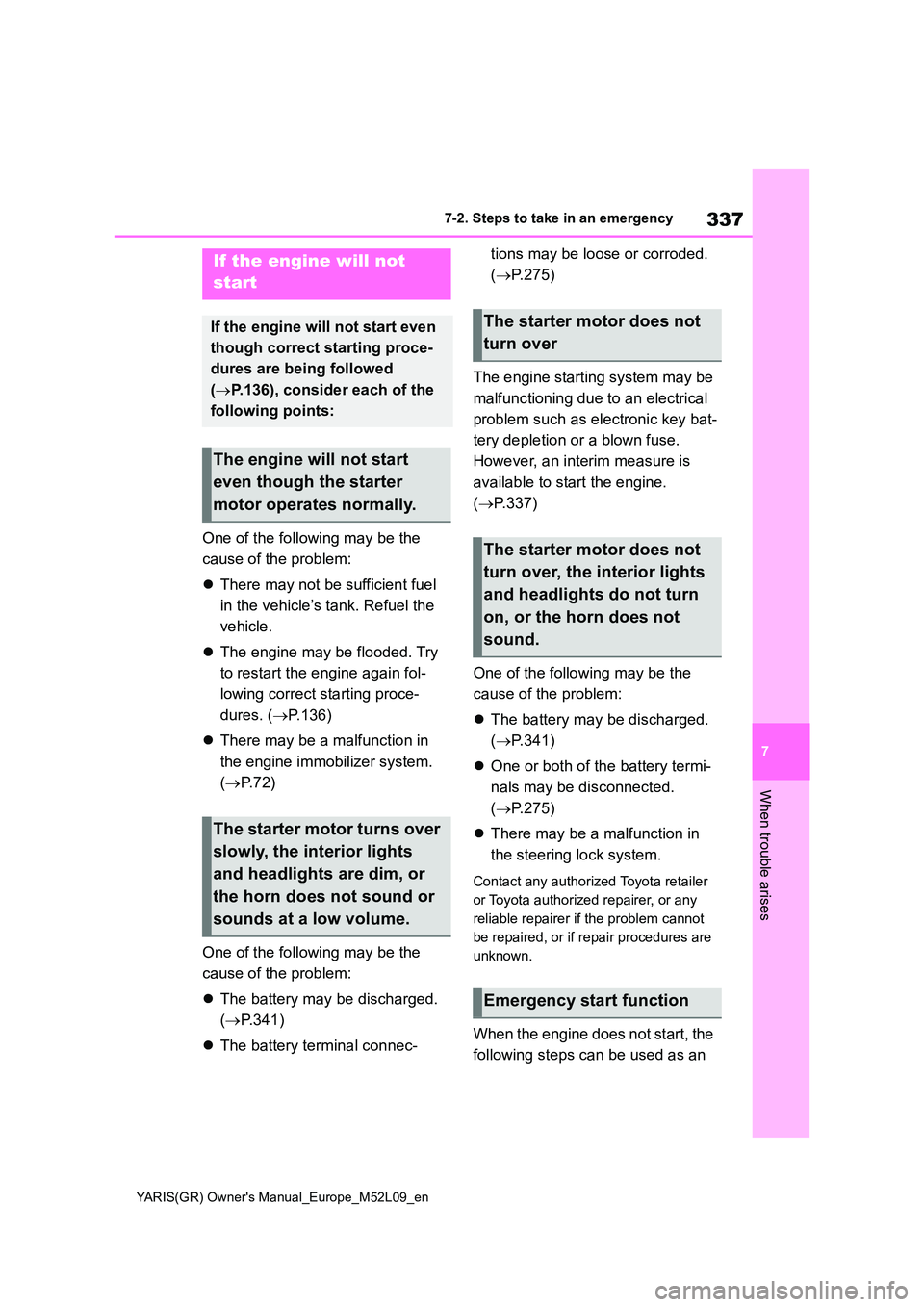
337
7
YARIS(GR) Owner's Manual_Europe_M52L09_en
7-2. Steps to take in an emergency
When trouble arises
One of the following may be the
cause of the problem:
�z There may not be sufficient fuel
in the vehicle’s tank. Refuel the
vehicle.
�z The engine may be flooded. Try
to restart the engine again fol-
lowing correct starting proce-
dures. ( →P.136)
�z There may be a malfunction in
the engine immobilizer system.
( →P. 7 2 )
One of the following may be the
cause of the problem:
�z The battery may be discharged.
( →P.341)
�z The battery terminal connec-
tions may be loose or corroded.
( →P.275)
The engine starting system may be
malfunctioning due to an electrical
problem such as electronic key bat-
tery depletion or a blown fuse.
However, an interim measure is
available to start the engine.
( →P.337)
One of the following may be the
cause of the problem:
�z The battery may be discharged.
( →P.341)
�z One or both of the battery termi-
nals may be disconnected.
( →P.275)
�z There may be a malfunction in
the steering lock system.
Contact any authorized Toyota retailer
or Toyota authorized repairer, or any
reliable repairer if the problem cannot
be repaired, or if repair procedures are
unknown.
When the engine does not start, the
following steps can be used as an
If the engine will not
start
If the engine will not start even
though correct starting proce-
dures are being followed
( →P.136), consider each of the
following points:
The engine will not start
even though the starter
motor operates normally.
The starter motor turns over
slowly, the interior lights
and headlights are dim, or
the horn does not sound or
sounds at a low volume.
The starter motor does not
turn over
The starter motor does not
turn over, the interior lights
and headlights do not turn
on, or the horn does not
sound.
Emergency start function
Page 443 of 458
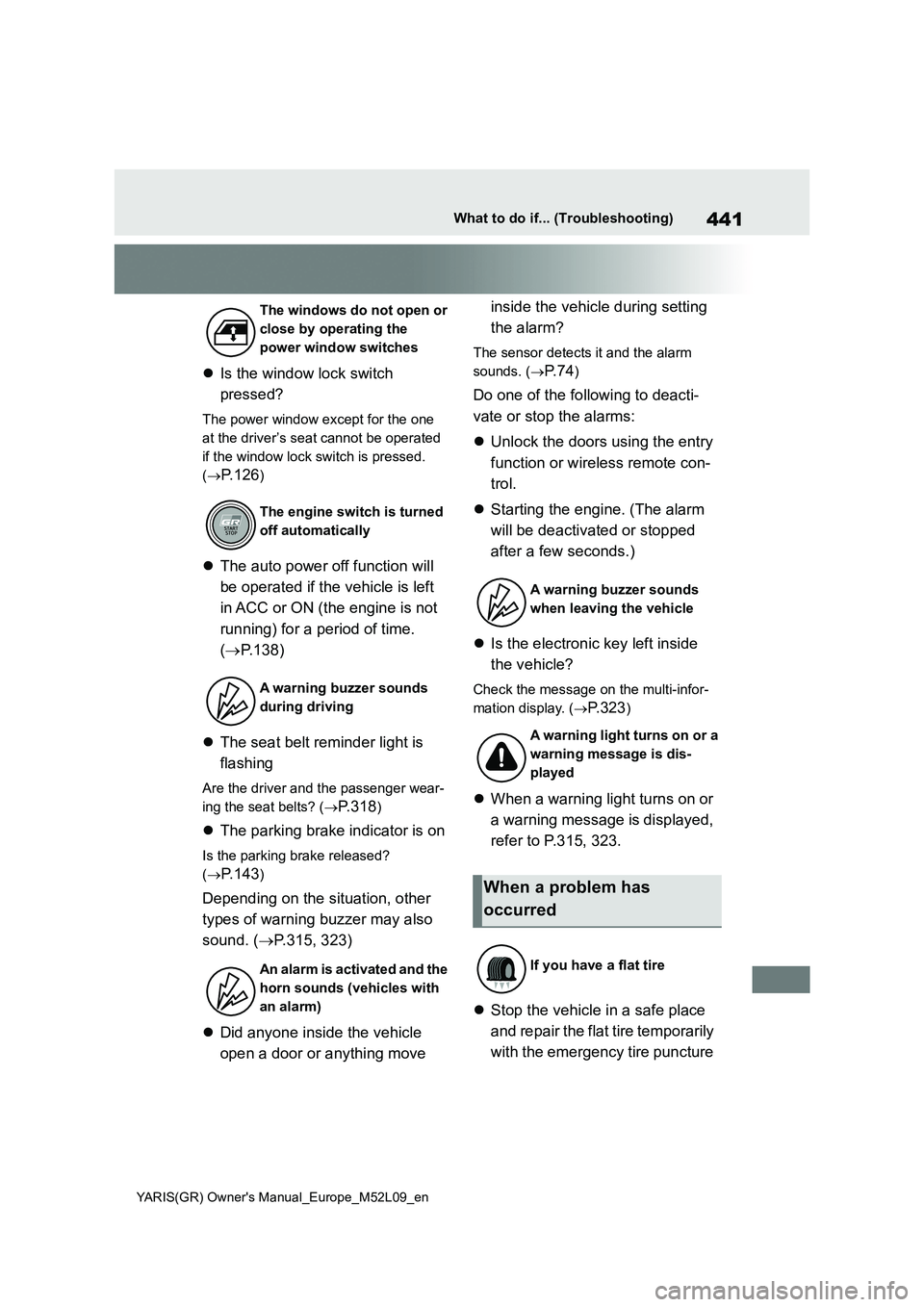
441
YARIS(GR) Owner's Manual_Europe_M52L09_en
What to do if... (Troubleshooting)
�zIs the window lock switch
pressed?
The power window except for the one
at the driver’s seat cannot be operated
if the window lock switch is pressed.
(→
P. 1 2 6)
�zThe auto power off function will
be operated if the vehicle is left
in ACC or ON (the engine is not
running) for a period of time.
(→P.138)
�zThe seat belt reminder light is
flashing
Are the driver and the passenger wear-
ing the seat belts? (→
P.318)
�zThe parking brake indicator is on
Is the parking brake released?
(→
P. 1 4 3)
Depending on the situation, other
types of warning buzzer may also
sound. (→P.315, 323)
�zDid anyone inside the vehicle
open a door or anything move inside the vehicle during setting
the alarm?
The sensor detects it and the alarm
sounds. (→
P. 7 4)
Do one of the following to deacti-
vate or stop the alarms:
�zUnlock the doors using the entry
function or wireless remote con-
trol.
�zStarting the engine. (The alarm
will be deactivated or stopped
after a few seconds.)
�zIs the electronic key left inside
the vehicle?
Check the message on the multi-infor-
mation display. (→
P.323)
�zWhen a warning light turns on or
a warning message is displayed,
refer to P.315, 323.
�zStop the vehicle in a safe place
and repair the flat tire temporarily
with the emergency tire puncture
The windows do not open or
close by operating the
power window switches
The engine switch is turned
off automatically
A warning buzzer sounds
during driving
An alarm is activated and the
horn sounds (vehicles with
an alarm)
A warning buzzer sounds
when leaving the vehicle
A warning light turns on or a
warning message is dis-
played
When a problem has
occurred
If you have a flat tire
Page 450 of 458
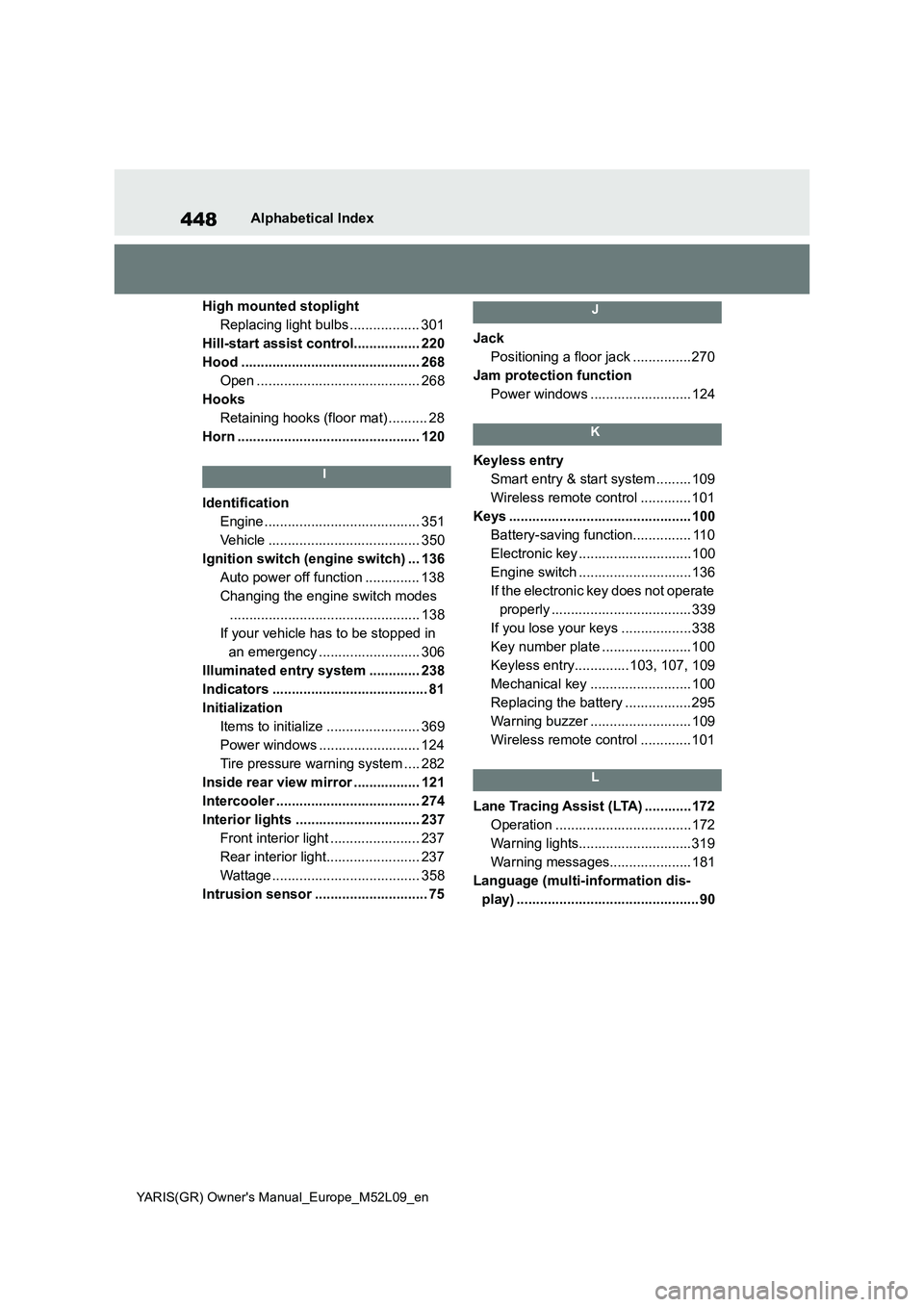
448
YARIS(GR) Owner's Manual_Europe_M52L09_en
Alphabetical Index
High mounted stoplight
Replacing light bulbs .................. 301
Hill-start assist control................. 220
Hood .............................................. 268
Open .......................................... 268
Hooks
Retaining hooks (floor mat) .......... 28
Horn ............................................... 120
I
Identification
Engine ........................................ 351
Vehicle ....................................... 350
Ignition switch (engine switch) ... 136
Auto power off function .............. 138
Changing the engine switch modes
................................................. 138
If your vehicle has to be stopped in
an emergency .......................... 306
Illuminated entry system ............. 238
Indicators ........................................ 81
Initialization
Items to initialize ........................ 369
Power windows .......................... 124
Tire pressure warning system .... 282
Inside rear view mirror ................. 121
Intercooler ..................................... 274
Interior lights ................................ 237
Front interior light ....................... 237
Rear interior light........................ 237
Wattage ...................................... 358
Intrusion sensor ............................. 75
J
Jack
Positioning a floor jack ............... 270
Jam protection function
Power windows .......................... 124
K
Keyless entry
Smart entry & start system ......... 109
Wireless remote control ............. 101
Keys ............................................... 100
Battery-saving function............... 110
Electronic key .............................100
Engine switch .............................136
If the electronic key does not operate
properly .................................... 339
If you lose your keys ..................338
Key number plate .......................100
Keyless entry.............. 103, 107, 109
Mechanical key .......................... 100
Replacing the battery ................. 295
Warning buzzer .......................... 109
Wireless remote control ............. 101
L
Lane Tracing Assist (LTA) ............172
Operation ...................................172
Warning lights.............................319
Warning messages..................... 181
Language (multi-information dis-
play) ............................................... 90